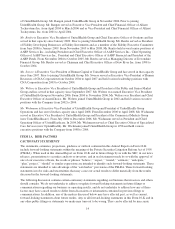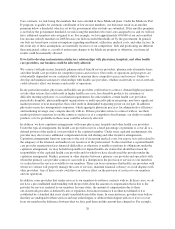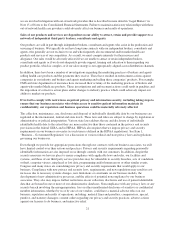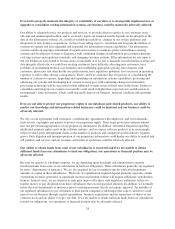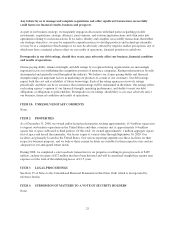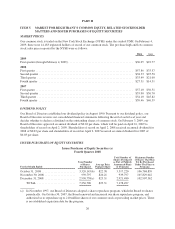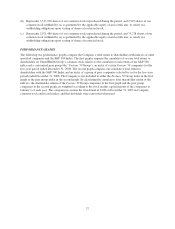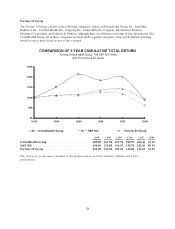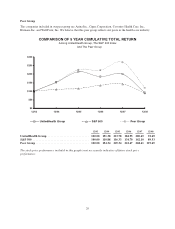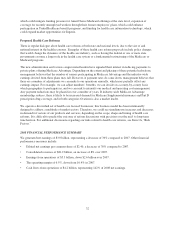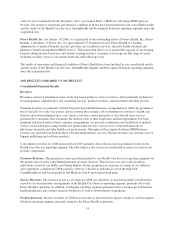United Healthcare 2008 Annual Report Download - page 34
Download and view the complete annual report
Please find page 34 of the 2008 United Healthcare annual report below. You can navigate through the pages in the report by either clicking on the pages listed below, or by using the keyword search tool below to find specific information within the annual report.If we fail to properly maintain the integrity or availability of our data or to strategically implement new or
upgrade or consolidate existing information systems, our business could be materially adversely affected.
Our ability to adequately price our products and services, to provide effective service to our customers in an
efficient and uninterrupted fashion, and to accurately report our financial results depends on the integrity of the
data in our information systems. As a result of technology initiatives, changes in our system platforms and
integration of new business acquisitions, we have been taking steps to consolidate and integrate the number of
systems we operate and have upgraded and expanded our information systems capabilities. Our information
systems require an ongoing commitment of significant resources to maintain, protect and enhance existing
systems and develop new systems to keep pace with continuing changes in information processing technology,
evolving systems and regulatory standards, and changing customer patterns. If the information we rely upon to
run our businesses were found to be inaccurate or unreliable or if we fail to maintain our information systems and
data integrity effectively, we could lose existing customers, have difficulty attracting new customers, have
problems in determining medical cost estimates and establishing appropriate pricing, have disputes with
customers, physicians and other health care professionals, have regulatory problems, have increases in operating
expenses or suffer other adverse consequences. There can be no assurance that our process of consolidating the
number of systems we operate, upgrading and expanding our information systems capabilities, protecting and
enhancing our systems and developing new systems to keep pace with continuing changes in information
processing technology will be successful or that additional systems issues will not arise in the future. Failure to
consolidate and integrate our systems successfully could result in higher than expected costs and diversion of
management’s time and energy, which could materially impact our business, financial condition and operating
results.
If we are not able to protect our proprietary rights to our databases and related products, our ability to
market our knowledge and information-related businesses could be hindered and our business could be
adversely affected.
We rely on our agreements with customers, confidentiality agreements with employees, and our trademarks,
trade secrets, copyrights and patents to protect our proprietary rights. These legal protections and precautions
may not prevent misappropriation of our proprietary information. In addition, substantial litigation regarding
intellectual property rights exists in the software industry, and we expect software products to be increasingly
subject to third-party infringement claims as the number of products and competitors in this industry segment
grows. Such litigation and misappropriation of our proprietary information could hinder our ability to market and
sell products and services and our revenues and results of operations could be adversely affected.
Our ability to obtain funds from some of our subsidiaries is restricted and if we are unable to obtain
sufficient funds from our subsidiaries to fund our obligations, our operations or financial position may be
adversely affected.
Because we operate as a holding company, we are dependent upon dividends and administrative expense
reimbursements from some of our subsidiaries to fund our obligations. These subsidiaries generally are regulated
by states’ departments of insurance. We are also required by law to maintain specific prescribed minimum
amounts of capital in these subsidiaries. The levels of capitalization required depend primarily upon the volume
of premium revenues generated. A significant increase in premium volume will require additional capitalization
from us. In most states, we are required to seek prior approval by these state regulatory authorities before we
transfer money or pay dividends from these subsidiaries that exceed specified amounts. In addition, we normally
notify the state departments of insurance prior to making payments that do not require approval. An inability of
our regulated subsidiaries to pay dividends to their parent companies could impact the scale to which we could
reinvest in our business through capital expenditures, business acquisitions and the repurchase of shares of our
common stock and our ability to repay our debt. If we are unable to obtain sufficient funds from our subsidiaries
to fund our obligations, our operations or financial position may be adversely affected.
24


